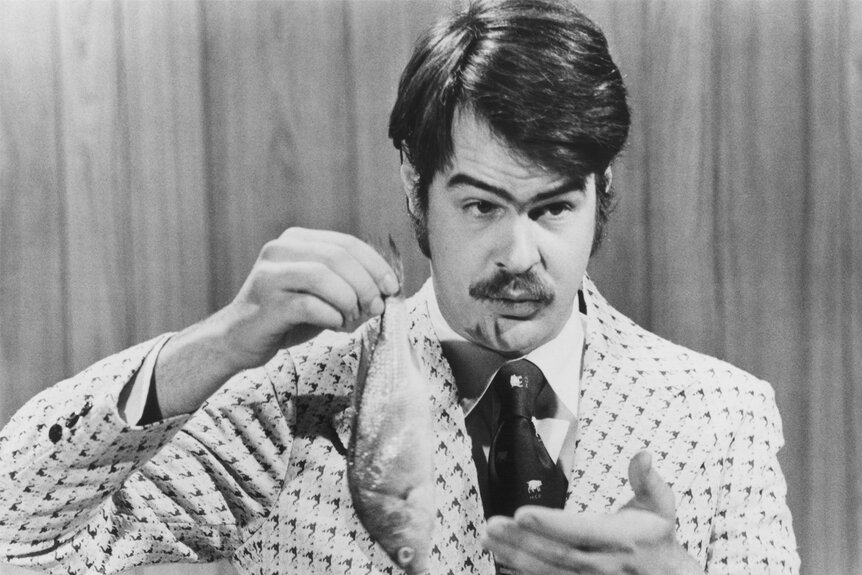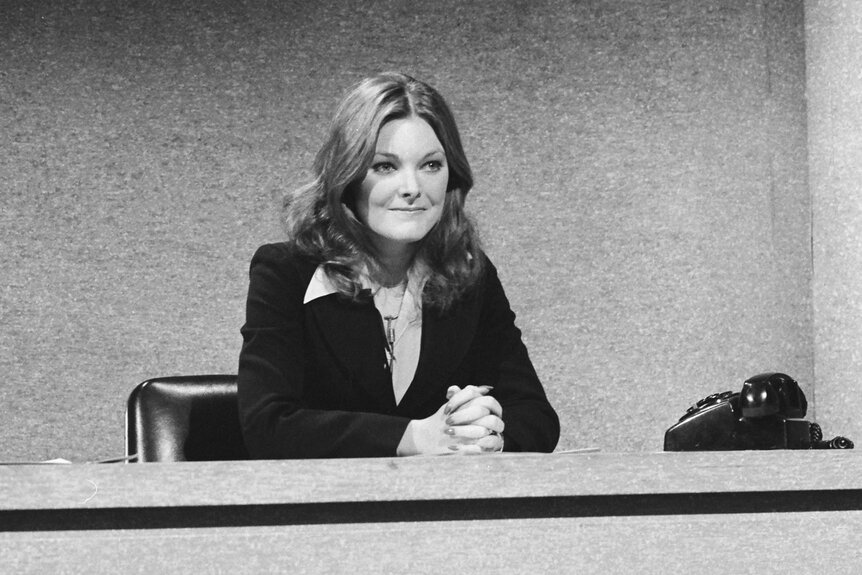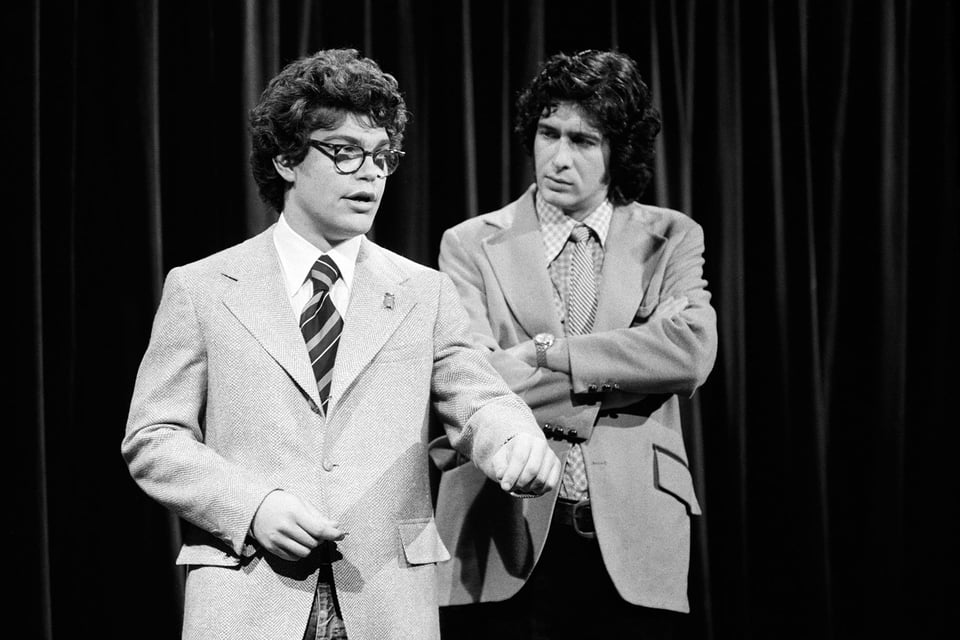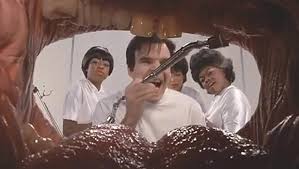It's September 24th, 1977, the host is Steve Martin and the Musical Guest is Jackson Browne

Here's some stuff that happened in the past

When I think about Saturday Night Live’s early years, one of the first images that spring to mind are Steve Martin and Dan Aykroyd in impossibly loud shirts, ineptly hitting on American women in a rough approximation of an Eastern European accent.
Yet the Wild and Crazy Guys were not part of the show’s first or second season. Steve Martin was a popular host in the comic institution’s first two years, but he wasn’t synonymous with Saturday Night Live until he began having his own recurring characters and catchphrases.
That happens very early in the season premiere of Saturday Night Live’s third season. After a monologue where Martin performed some of his favorite hits and plugged his new album Let’s Get Small, Martin and Aykroyd introduced The Festrunk Brothers, who would become one of the show’s most popular characters.
I was surprised to learn that Mary Suzanne Miller, who carved out a rich niche for herself by writing character-based sketches rich in humanity and humor with good, juicy roles for women rather than relying on catchphrases and shock humor, was one of the writers of the Festrunk, Brothers sketches.

Miller’s participation makes more sense when you consider the characters’ original, oft-ignored context. The Festrunk Brothers are products of a Cold War that has been over for decades but loomed large in the public until the fall of the Soviet Union.
The Festrunk Brothers are Czechoslovakian immigrants who gave up lives of privilege and distinction in their homeland to start at the bottom in the materialistic wonderland of the United States.
It’s culture-clash comedy that derives its humor from the impossibly vast gulf between how cool, sexy, and appealing the clueless brothers think they are and their actual obliviousness.
The Festrunk are guileless in their enthusiasm for large American breasts and sexy women who love to swing, but they seem more interested in themselves and each other than the poor women subjected to their inept advances.
There’s something innately bittersweet and melancholy about these buffoons who were kings in their homeland and clowns in our country. The Festrunk Brothers would become known for their horniness, cluelessness, and lust for large-breasted American women, but at the start, at least, they possessed a humanity generally lacking in catchphrase-spouting recurring characters.

In his monologue, Martin assumes the smarmy, overly ingratiating persona of a consummate show-business phony. Some of Martin’s jokes are absurdist to the point of being nonsensical, but his road-honed delivery sells them.
This episode marks Dan Aykroyd’s debut as a “Weekend Update” co-anchor, but he does not seem terribly comfortable in his new role. Bill Murray, in sharp contrast, helped establish his voice on the show as a movie critic who does not bother seeing the movies he’s ostensibly reviewing.
The character of the “Weekend Update” movie reviewer helped establish Murray’s persona as a gladhanding, patently insincere entertainer who treats the audience like a show-biz pal.
In its third season, the sketches got longer. That could be a big problem if a sketch does not work. Unfortunately, that describes a painful sketch in which Laraine Newman plays Cynthia PlasterCaster, the artist who enriched our lives by making plaster casts out of the dongs of legendary musicians.
This sketch focuses on PlasterCaster’s desire to score a pair of Roy Orbison’s trademark sunglasses. The sketch’s paper-thin premise is that Orbison was known for standing perfectly still on stage and wearing sunglasses, and when he gives PlasterCaster a pair of shades, it disturbs his equilibrium so that he’s soon lurching all over the stage while performing “Pretty Woman.”
The comedy team Al Franken and Tom Davis get their showcase in the high-profile season premiere, but of course, they have a slot late in the show, when much of the audience has fallen asleep or is too stoned to follow the action.
The daffy duo’s sketch imagines a Mrs. America contest with all male contestants. It’s a switcheroo that highlights the incredibly condescending, sexist essence of beauty pageants.
Beauty pageants are all about women competing to prove that they have mastered the art of being what society, and more specifically, men, want them to be: beautiful, thin, young, ambitious but not too ambitious, and intelligent enough to speak coherently but not enough to challenge social norms.

So there is something subversive about replacing beautiful, scantily-clad, painfully sincere young women competing for the crown with dudes played by Franken and Davis.
Saturday Night Live has always had a meta streak. Albert Brooks, Steve Martin, and Andy Kaufman all created comedy that explored the nature of comedy and entertainment and the strange bond between audience and performer. It was about making people laugh but also examining why they laugh and what that means.
Franken & Davis’ most inspired bits play into this playful post-modernism.
The season premiere featured new opening credits that are astonishingly ugly and wrong-headed. Instead of lovely still images of Manhattan nightlife and the cast at play, we’re treated to ugly pixelated Jumbotron images of the Not Ready for Prime Time Players that don’t look like the cast.
Instead of offering fragile smiles, the cast frowns in the opening credits, looking miserable and weirdly dour.
The show feels the need to switch up the opening credits seemingly randomly. Thankfully, these eyesores didn’t last too long and were replaced by opening credits that were far more elegant and distinctive.

Steve Martin established himself as not just a Saturday Night Live host but the host of the show’s early years. The show and Martin enjoyed a symbiotic relationship that would only grow in the ensuing years, even after the original cast left for greener pastures and/or died tragically. This episode represents a milestone in a relationship that would have a significant impact on Saturday Night Live and comedy in general.
You just read issue #63 of Every Episode Ever. You can also browse the full archives of this newsletter.
-
I always thought of the Festrunk Brothers as the Czech cousins to the Butabi Brothers.
Add a comment: